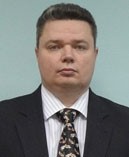DESIGNING ALGORITHMS FOR SOLVING PHYSICS PROBLEMS ON THE BASIS OF MIVAR APPROACH
Аннотация
Ключевые слова
Полный текст:
 >PDF (English)
>PDF (English)
Литература
Chibirova M.O. (2015), Mivar approach expansion: Classes and relations, Radio industry, No.3, pp. 44–54.
Varlamov O.O. (2005), “About the possibility of developing intelligent systems on the basis of GRID, adaptive synthesis systems Information Computational Configurations (ICC), service-oriented architectures and mivar-oriented information space” [“O vozmozhnosti sozdaniya intellektual’nyh sistem na osnove GRID, sistem adaptivnogo sinteza IVK, servisno-orientirovannoj arhitektury i mivarnogo informacionnogo prostranstva”], Proceedings of Taganrog State Radio Engineering University, No. 10, pp. 130–140.
Varlamov O.O. (2013), “Practical implementation of linear computational complexity of logical inference using if-then rules in mivar nets and processing of more than three million rules” [“Prakticheskaya realizaciya linejnoj vychislitel’noj slozhnosti logicheskogo vyvoda na pravilah “esli-to” v mivarnyh setyah i obrabotka bolee trekh millionov pravil”], Automation and control in technical systems, No.1, pp. 60–97.
Varlamov O.O. (2007), “About the necessity of transition from artificial intelligence theory to development of active reflection theory” [“O neobhodimosti perekhoda ot teorii iskusstvennogo intellekta k razrabotke teorii aktivnogo otrazheniya], Proceedings of Southern Federal University, Vol. 77, No. 2, pp. 89–95.
Varlamov O.O. The review of twenty-five-year development of mivar approach to designing intelligent systems and artificial intelligence. Proceedings of NIIR. 2011, No. 1, pp. 34–44.
Varlamov O.O. The fundamentals of multi-dimensional information developing (mivar) space of data and rule representation. 2003. Information technologies, No. 5, pp. 42–47.
Varlamov O.O. Parallel information flow processing on the basis of virtual database flows. Proceedings of Universities. Electronics. 2003, No. 5, pp. 82–89.
8. Varlamov O.O. (2002), “Development of adaptive mechanism of logical inference on evolutionary interactive network of hyper-rules with multi-activators managed by data flow” [“Razrabotka adaptivnogo mekhanizma logicheskogo vyvoda na ehvolyucionnoj interaktivnoj seti giperpravil s mul’tiaktivizatorami, upravlyaemoj potokom dannyh”], Artificial intelligence, No. 3, pp. 363–370.
Varlamov O.O. Logical artificial intelligence has been developed on the basis of mivar approach! MIVAR: active databases with linear logical inference > 3 million rules => meaning understanding + singularity in virtual reality. Saarbrucken, Germany: LAP LAMBERT Academic Publishing Gmbh & Co. KG, 2012. 700 p.
Varlamov O.O. Development of the method for paralleling multiple thread access to common database under conditions of prevention of mutual data corruption. Information technologies. 2003. No. 1. pp. 20–28.
Chuvikov D.A., Kazakova N.A., Varlamov O.O., Hadiev A.M. (2014), “Analysis of technologies of three-dimensional modelling and 3d object development for different intelligent systems [“Analiz tekhnologij trekhmernogo modelirovaniya i sozdaniya 3d ob”ektov dlya razlichnyh intellektual’nyh system”], Automation and control in technical systems, No. 2.1, pp. 84–97.
Varlamov O.O. (2005), “Development of intelligent systems on the basis of interaction between mivar-oriented information space and service oriented architecture” [“Sozdanie intellektual’nyh sistem na osnove vzaimodejstviya mivarnogo informacionnogo prostranstva i servisno-orientirovannoj arhitektury”], Artificial intelligence, No.3, pp. 13–17.
Varlamov O.O. (2007), “Development of active reflection theory as generalization of artificial intelligence theory and possibility of its implementation in mivar-oriented information space” [“Sozdanie teorii aktivnogo otrazheniya kak obobshcheniya teorii iskusstvennogo intellekta i vozmozhnost’ ee realizacii v mivarnom infoprostranstve”], Artificial intelligence, No. 3, pp. 17–24.
Chuvikov D.A. (2015), Development of electronic learning resource (ELR) “MIVAR”. “MIVAR” – logical artificial intelligence, Saarbrucken, Germany: LAP LAMBERT Academic Publishing Gmbh & Co. KG, 2012. 65 p.
Zhdanovich E.A., Chernychev K.A., Yufimychev K.A., Eliseev D.V., Chuvikov D.A. (2015), “Random algorithms calculation of service robot functioning based on mivar approach” [“Vychislenie proizvol’nyh algoritmov funkcionirovaniya servisnyh robotov na osnove mivarnogo podhoda”], Radio industry, No. 3, pp. 226–242.
Varlamov O.O., Chuvikov D.A. (2015), The use of mivar-based approach for solving problems related to simulation modelling, Seventh All-Russia scientific-practical conference “Simulation modelling. Theory and Practice “(IMMOD 2015) Proceedings of the conference: In 2 vol. Trapeznikov’s Institute of Control Sciences of Russian Academy of Sciences, Edited by Vasilyev S.N., Yusupova R.M., Moscow, pp. 280–284.
Chuvikov D.A. (2015), “Procedural animation application in solving intelligent tasks and problems related to situational three-dimensional modelling” [“Primenenie procedurnoj animacii v reshenii intellektual’nyh zadach i problem, svyazannyh s situacionnym trekhmernym modelirovaniem”], Radio industry, No. 3, pp. 184–190.
Chuvikov D.A. (2015), “Physics engine application in solving tasks related to situational three-dimensional modelling” [“Primenenie fizicheskogo dvizhka v reshenii zadach, svyazannyh s situacionnym trekhmernym modelirovaniem v real’nom vremeni”], Radio industry, No. 3, pp. 191–199.
Chuvikov D.A. (2015), “Graphics engine application in solving intelligent tasks related to situational three-dimensional modelling” [“Primenenie graficheskogo dvizhka v reshenii intellektual’nyh zadach, svyazannyh s situacionnym trekhmernym modelirovaniem”], Radio industry, No. 3, pp. 200–209.
Varlamov O.O. (2002), Evolutionary databases and knowledge bases for adaptive synthesis of intelligent systems. Mivar-oriented information space. [Evolyucionnye bazy dannyh i znanij dlya adaptivnogo sinteza intellektual’nyh sistem. Mivarnoe informacionnoe prostranstvo], Radio and communications, Moscow, 288 p.
DOI: https://doi.org/10.12731/2227-930X-2016-3-31-50
Ссылки
- На текущий момент ссылки отсутствуют.
(c) 2017 Dmitry Alekseevich Chuvikov, Konstantin Vladimirovich Nazarov

Это произведение доступно по лицензии Creative Commons «Attribution-NonCommercial-NoDerivatives» («Атрибуция — Некоммерческое использование — Без производных произведений») 4.0 Всемирная.
Контент доступен под лицензией Creative Commons Attribution-NonCommercial-NoDerivs 4.0.
ISSN 2328-1391 (print), ISSN 2227-930X (online)

